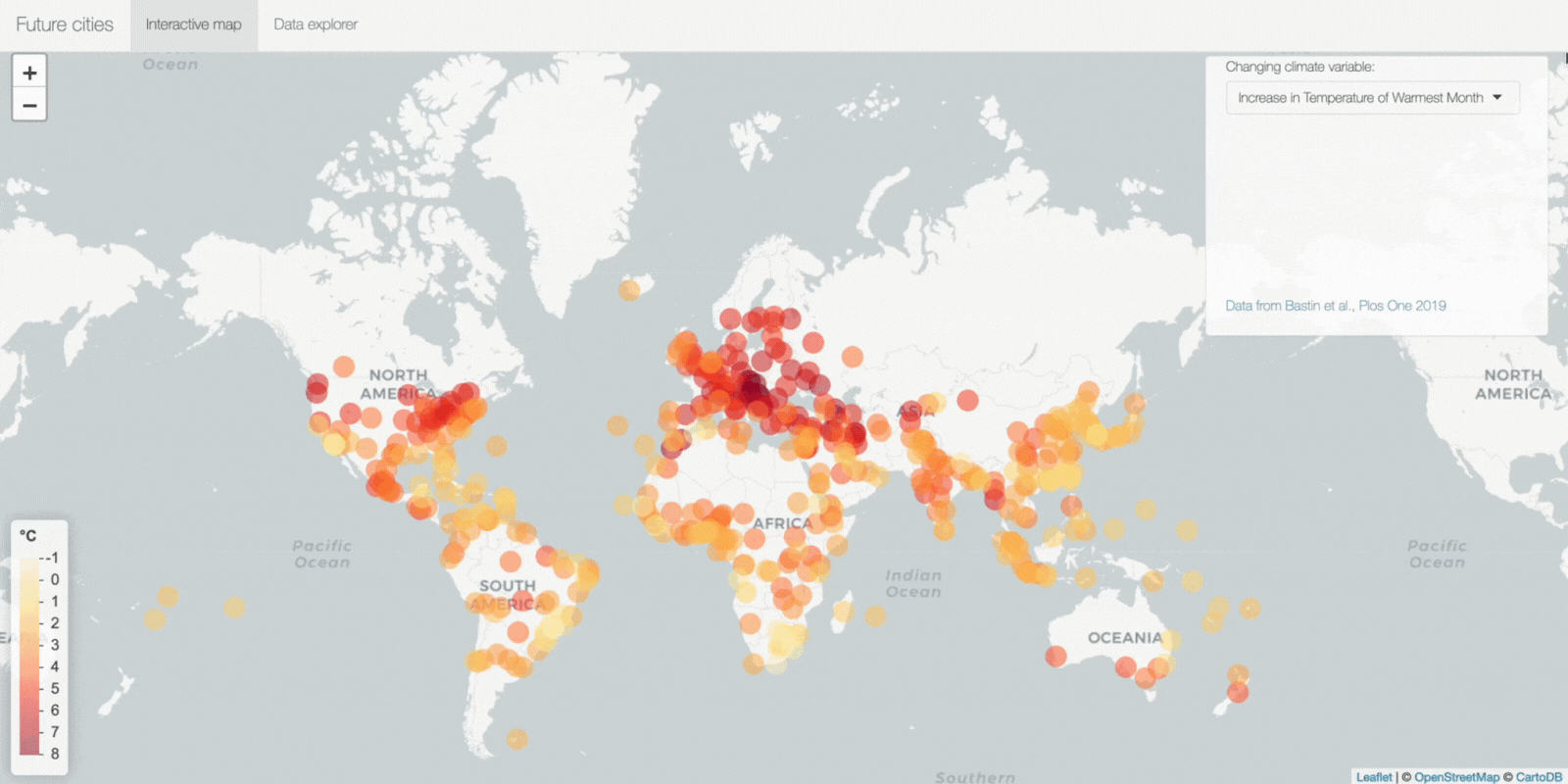Our climate future
Millions marching the streets, daily articles in every newspaper and a biodiversity agreement in Montreal: the topic of climate change is on all our minds. The problem: We only have a decade to act. If carbon emissions remain unabated (IPCC scenario RCP 4.5), the Earth is expected to be 2.0° – 2.5° C warmer by 2050. The costs associated with this level of warming are expected to exceed $12 trillion by 2050. But what does this mean? It means we have to act – and we have to act now.
We have to work together to address climate change. However, a growing body of evidence suggests that facts and data, which are often hard to understand, do not necessarily persuade people to act. Behavioral change is much more likely to be inspired by visualizations that make climate issues tangible.
Our research: demonstrating the impact of climate change
With our analysis, we aim to do just this. Rather than describing quantitative change variables, we paired the predicted climate conditions of 520 major cities in 2050 with analogues conditions of cities around the world today. We thereby demonstrate concrete scenarios for the future of the life in those cities. By making data relatable, we hope to motivate citizens and policy makers to adapt their decision making accordingly.
Our analysis is the result of a debate hosted at the Crowther Lab among an interdisciplinary group of researchers working on understanding and addressing climate change and biodiversity loss. Given the urgency to act against climate change, we spend a full day doing the required calculations, data analysis and building this report and thereby show that many answers are already here.
Visualising climate change
For our analysis we extracted 19 current and future bioclimatic variables from the coordinates of 520 cities around the world, consisting of major administrative capitals and cities with over 1 million inhabitants. These variables reflect the variability in temperature, precipitation as well as their monthly extremes and annual average. Future conditions for the year 2050 were calculated based on the IPCC’s Representative Concentration Pathway RCP4.5, which represents an optimistic scenario where the implementation of mitigation policies will have stabilized CO2 emissions by the mid-century and the mean global temperature will have increased by 1.4° C. Therefore, our results represent a best case scenario.
In a second step, we used a multivariate approach to analyse the climate similarity of all current and future cities. When compared pairwise, we saw that only four out of 19 bioclimatic components are predominant, accounting for more than 85% of the total variation in climate: the temperate seasonality, the minimum temperature in the coldest month, the maximum temperature in the warmest month, the precipitation seasonality, the precipitation of the driest and the wettest month, as well as the temperature diurnal range. Subsequently, all other variables were dropped for the comparison.
In order to achieve our goal of visualizing the climatic changes of cities in the future to enable citizens and decision makers to grasp the impact of climate change, we paired each future city with its three closest current cities based on the dissimilarity value. This allows us to show which city will remain relatively similar to how it is now and which will shift, resembling more the current climate of another city by 2050. By keeping three cities as a basis for comparison, we ensure that at least one of the three is known to the reader.
A warmer, drier world: Current vs. future cities
Our analysis shows that 77% of the cities around the world will experience a striking change of climate conditions, with 22% encountering conditions that currently don’t exist.
The most dramatic shift will occur in cities in northern latitudes with their climate in 2050 resembling today’s climate of cities over 1,000 km to their south. In Europe specifically, cities will be 3,5° C warmer in summer and 4,7° C in winter. This means that London, for example, will resemble today’s Barcelona, Stockholm today’s Vienna.
Tropical regions will experience smaller changes in temperature, but significant shifts in precipitation with the wettest months being 5% wetter and the driest months 14% drier. Overall the tropics will become drier and droughts more severe. However, these predictions are to be considered as best case and contain a high proportion of uncertainty as out of the 22% of cities that will experience novel climate conditions, 64% are located in the tropics.
Generally speaking, we observed changes towards less temperature seasonality, with higher maximal and minimal temperatures during the year, as well as higher precipitation seasonality with higher precipitation in the wettest but lower in the driest month. The daily difference between cities’ maximum and minimum temperatures will increase. In brief, by 2050 cities of the world will have become hotter, in particular during the winter and the summer. Wet seasons will be wetter and dry seasons drier.
We believe that it is through this comparison with current cities and their known struggles with their climate conditions that the need to act becomes tangible. In 2008, for example, Barcelona experienced extreme drought with severe implications on the well-being of its population and the consequent need to import €22M of drinking water. Even though our analysis contains uncertainties and the predictions may change as Earth system models are refined, it may provide the context to facilitate the development of more targeted climate strategies.
To learn more, read the full paper here: https://journals.plos.org/plosone/article?id=10.1371/journal.pone.0217592

